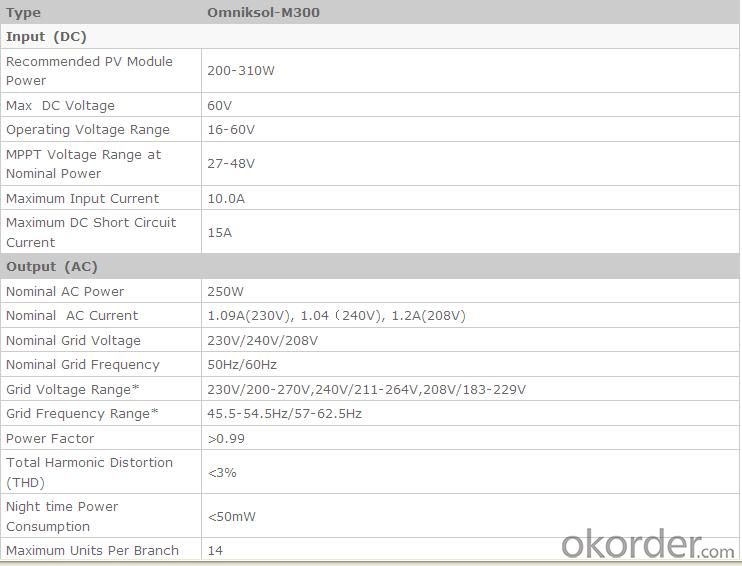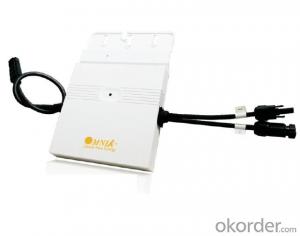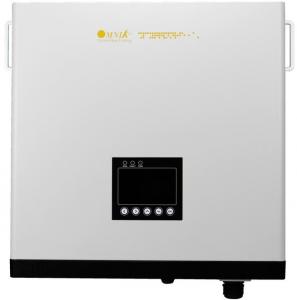Micro inverter Omniksol-M300 with standart 1 pcs solar panel
- Loading Port:
- Shanghai
- Payment Terms:
- TT OR LC
- Min Order Qty:
- 6 pc
- Supply Capability:
- 3000 pc/month
OKorder Service Pledge
OKorder Financial Service
You Might Also Like
Micro inverter Omniksol-M300 with standart 1 pcs solar panel
Omniksol-2.0k-TL Photon Efficiency up to 3kW
in the world------ Photon tested Jan. 2012.
Omniksol-M248
1.Futures
High efficiency(Max.96.3%)
Reduce shading issues, improve the generating capacity of the whole solar PV system
AC/DC high frequency isolation technology
Maximum connection of 14 Micro-inverters
Adopted electric power carrier communication
Easy design, Plug-and-play chain installation
Remote monitor to each module
integrated ENS function, complied with safety standard,can be connected to grid directly
2.Technical data:

3. Product certificate
EN 61000
VDE 0126-1-1
C10/11
G83/2
UTE C15-712-1
AS4777
CQC
CE10-21
EN50438
4.Product outlook

1. How long will my inquiry get response?
Your inquiry related to our products or prices will be replied within 24 hours.
2. Can I get professional service and suggestion?
Well-trained and experienced staffs to answer all your questions in fluent English.
3. Do you accept OEM or customized design?
OEM & ODM, any your customized lightings we can help you to design and put into product.
4. What if I need specific design?
Distributorship are offered for your unique design and some our current models.
- Q:How long do solar inverters typically last?
- Solar inverters typically last for around 10 to 15 years, although some high-quality inverters can last up to 20 years with proper maintenance and regular inspections.
- Q:What are the key safety features to look for in a solar inverter?
- The key safety features to look for in a solar inverter include overvoltage protection, ground fault protection, arc fault protection, and rapid shutdown capability. These features help ensure the safe and efficient operation of the solar system, protecting against electrical hazards and reducing the risk of fire or injury.
- Q:Can a solar inverter be used with a solar-powered water pump?
- Yes, a solar inverter can be used with a solar-powered water pump. The solar inverter converts the DC power generated by the solar panels into AC power, which is suitable for powering the water pump. This allows for efficient and reliable operation of the pump using solar energy.
- Q:How does a solar inverter handle voltage sags and swells?
- A solar inverter handles voltage sags and swells by continuously monitoring the voltage levels of the grid. When it detects a voltage sag (a drop in voltage below a certain threshold) or a voltage swell (a sudden increase in voltage above a certain threshold), the inverter adjusts its operation to compensate for the deviation. It can either decrease or increase the power output to ensure that the electricity being fed into the grid remains within acceptable voltage limits. This helps to stabilize the grid and protect connected devices from potential damage.
- Q:Can a solar inverter be connected to a computer or smartphone?
- Yes, a solar inverter can be connected to a computer or smartphone. Many modern solar inverters come with built-in Wi-Fi or Bluetooth capabilities that allow them to connect to these devices. Through dedicated mobile apps or software, users can monitor their solar system's performance, adjust settings, and receive real-time data and alerts directly on their computer or smartphone.
- Q:What is the impact of a solar inverter on the overall system cost?
- A solar inverter can have a significant impact on the overall system cost. It is an essential component that converts the direct current (DC) produced by solar panels into alternating current (AC) that can be used by electrical appliances and fed into the grid. The quality and efficiency of the inverter play a crucial role in optimizing the energy production and overall performance of the solar system. High-quality inverters tend to be more expensive but can enhance the system's reliability, lifespan, and energy yield. Therefore, while a solar inverter does add to the system cost, investing in a reliable and efficient one can result in long-term benefits and returns by maximizing the system's overall performance.
- Q:Can a solar inverter be used in a solar-powered telecommunications system?
- Yes, a solar inverter can be used in a solar-powered telecommunications system. A solar inverter is an essential component in such systems as it converts the DC (direct current) electricity generated by the solar panels into AC (alternating current) electricity, making it compatible with the telecommunication devices and equipment.
- Q:How does a solar inverter handle islanding detection and prevention?
- A solar inverter handles islanding detection and prevention by continuously monitoring the electrical grid's stability. It utilizes anti-islanding protection mechanisms to detect any abnormal conditions, such as voltage fluctuations or frequency deviations, that may indicate the presence of an islanded grid. In the event of islanding, the inverter immediately disconnects from the grid to prevent energy feed-in and effectively isolate the solar system. This ensures the safety of utility workers, prevents damage to equipment, and helps maintain the stability of the overall electrical grid.
- Q:Installation and maintenance of photovoltaic grid - connected inverter
- , any failure that affects the safety performance of the inverter must be immediately removed before turning on the inverter again.
- Q:How does a solar inverter interact with the electrical grid?
- A solar inverter interacts with the electrical grid by converting the direct current (DC) electricity generated by solar panels into alternating current (AC) electricity that is compatible with the grid. It synchronizes the generated electricity with the grid's voltage and frequency, allowing excess power to be fed back into the grid for others to use, and drawing additional power from the grid when needed. This interaction ensures efficient utilization of solar energy and seamless integration of solar power into the existing electrical grid infrastructure.
1. Manufacturer Overview |
|
|---|---|
| Location | |
| Year Established | |
| Annual Output Value | |
| Main Markets | |
| Company Certifications | |
2. Manufacturer Certificates |
|
|---|---|
| a) Certification Name | |
| Range | |
| Reference | |
| Validity Period | |
3. Manufacturer Capability |
|
|---|---|
| a)Trade Capacity | |
| Nearest Port | |
| Export Percentage | |
| No.of Employees in Trade Department | |
| Language Spoken: | |
| b)Factory Information | |
| Factory Size: | |
| No. of Production Lines | |
| Contract Manufacturing | |
| Product Price Range | |
Send your message to us
Micro inverter Omniksol-M300 with standart 1 pcs solar panel
- Loading Port:
- Shanghai
- Payment Terms:
- TT OR LC
- Min Order Qty:
- 6 pc
- Supply Capability:
- 3000 pc/month
OKorder Service Pledge
OKorder Financial Service
Similar products
New products
Hot products
Hot Searches
Related keywords






























